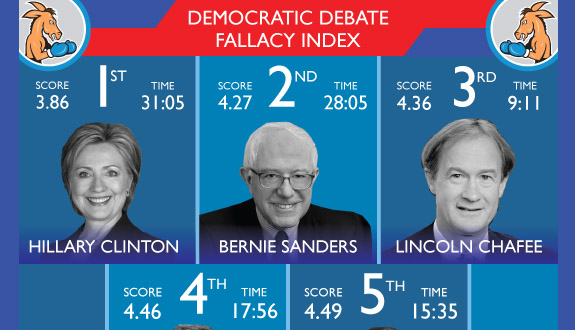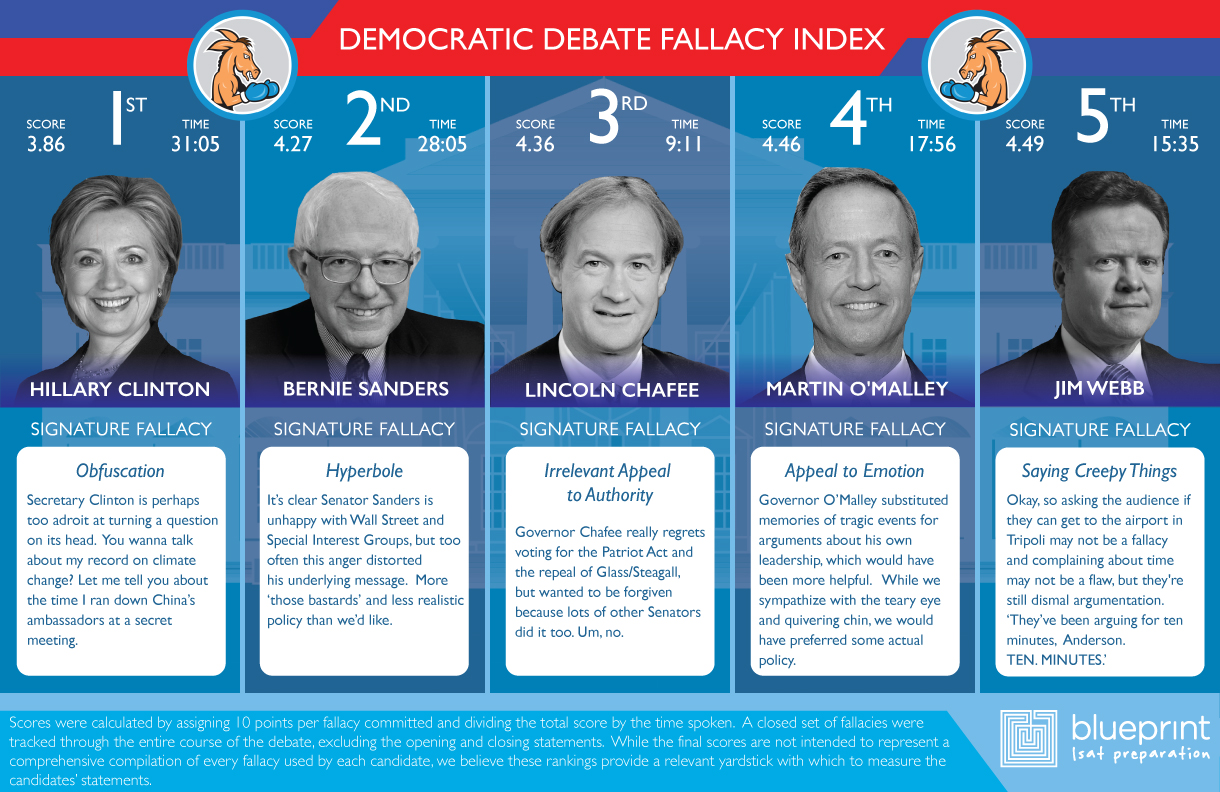Click image to enlarge
Since we prepare people to take the LSAT, identifying invalid arguments is our business at Blueprint. When particularly egregious arguments seep into our social discourse unimpeded, we believe it’s our duty to point out their illogic. It’s kind of like our version of picking up trash when we see it drifting by on the street.
It’s is an election year and the first two Republican Presidential Debates turned out to be cacophonies of poor reasoning. They were so absurd, in fact, we weren’t sure we could actually make sense of them. But since no casino-owner wearing a marmot carcass as hair would be participating in this evening’s debate, we expected a slightly saner affair. Accordingly, we thought it might be appropriate to deconstruct the candidates’ arguments to see if there was any suspect logic at work.
To this end, we had some of our finest LSAT instructors watch tonight’s Democratic Presidential Debate and analyze the arguments presented in order to identify fallacious reasoning. Admittedly, the analysis of arguments is not entirely uncontroversial and there’s no way a real-time analysis could purport to be completely comprehensive. But that doesn’t mean it isn’t worth a try.
Our Methodology
We analyzed each speaker’s responses to questions looking acutely for 1- fallacies that struck us as being the common in presidential debates we’ve seen thus far, only 8 of which actually occurred in this debate. For each fallacy committed we assigned the candidate ten points. But because the candidates who were given more time to speak (or took more time, sorry Jim Webb) had more opportunity to commit these fallacies, we divided their score by the time they spoke as measured by us and verified by the New York Times and CNN. With regard to our scores, here like in golf, you want a low score, since a higher score means that you committed more fallacies.
It should also be noted that we were just analyzing candidates’ responses to questions in this debate, not their campaign platforms generally. Thus, we weren’t testing for consistency with other statements they’ve made or their voting history. In addition, candidates predictably made unsubstantiated claims, such as Hillary Clinton’s that the economy performs better when Democrats are President (that isn’t obviously true according to some measures of economic performance) or ambiguous statements as Jim Webb’s that 15 of the 21 “most polluting” cities in the world are in China or India (it isn’t clear whether that’s pollution per capita or taken as an aggregate of the city’s entire population, and this might matter because most of the world’s largest 21 cities are in India and China). We didn’t count such statements simply because the candidates didn’t say enough for us to be sure they’d committed a fallacy. Suffice it to say, a less charitable eye will always find poorer reasoning in such debates, and we tried to be charitable to the candidates.
So what did we find? First, it seems fairly uncontroversial that the Democratic candidates were more civil to one another and answered questions a bit more directly than their Republican counterparts. This made for a better debate, if for poorer television. Second, these candidates unsurprisingly had so much in common that they used the debate primarily to distance themselves from the Republican Party. However, this is not to say that they were without logical missteps.
The candidates not only committed fallacies, but we found that each had characteristic fallacies to which he or she was prone:
Hillary Clinton committed the fallacy of obfuscation more than any other candidate in the debates tonight. She evaded the question asked more than others and attempted to redirect the line of inquiry to talking points with which she was more comfortable.
While we’re sympathetic to Bernie Sanders’ outrage at special interest groups and the disproportionate power of the uber-rich, his temerity too often disposed him to make hyperbolic claims straw-man reconstructions of his opponent’s arguments.
Martin O’Malley frequently lapsed into appeals to emotion when an argument would have been more appropriate, not the least of which was his teary-eyed remembrance of funerals he’s attended in Baltimore instead of an account of his own contributions to the city’s improvement.
Lincoln Chafee seemed to be appealing to popular opinion in matters that were more appropriately subject to his independent judgment, particularly when, on two different occasions, he seemed to want a pass for controversial votes he made in the Senate because, supposedly, a lot of other people voted that way as well.
As for Jim Webb, this is where the language of logic and fallacious reasoning runs out. We were struck by his appearing to forget the name of one of his daughters in his opening statement, his non-sequitur that it’s apparently difficult to find the airport in Tripoli as evidence that all is not well in Libya, his repeated complaints that he didn’t get enough time to speak (despite speaking for almost twice as much time as Lincoln Chafee), and the disquieting closing remark in which he seemed to brag about killing a man in the Vietnam war. Those aren’t logical fallacies — they’re just a bit creepy.
Based on the arguments that appeared in the debate, we enumerated a list on the types of fallacies that were most frequently used. Just in case you are a newcomer to the game of fallacies, we’ve included definitions and examples of everything we were tracking.
Fallacy of Obfuscation: This fallacy occurs when someone fails to address the matter at hand and instead redirects the discussion to a more favorable topic. When your girlfriend asks where you’ve been all evening and you respond, “Are those new pants?”, you’ve committed the fallacy of obfuscation.
Straw Man: An informal fallacy that results from ignoring the position advanced by an interlocutor and responding instead to a less reasonable or exaggerated version of his or her position. When your boyfriend says you should leave early to make your flight and you respond that he’s trying to control you by rushing you out of the house at the crack of dawn, you’ve made a straw man.
Fallacy of Inappropriate Appeal to Authority: This fallacy occurs when an argument relies crucially on the authority of an expert who is unreliable either because this expert has a bias or lacks expertise relevant to the question. When your mom tells you you’re a genius, it doesn’t really count.
Fallacy of Composition: This fallacy occurs when a conclusion is drawn about wholes from a premise about parts, or vice versa. Common examples include the team is bad, so each player is bad, or the employees are well paid, so the company is well paid.
Fallacies of Sampling or Survey: Arguments that rely on surveys as evidence are vulnerable to critique if the subjects surveyed didn’t understand the questions asked, had a motive to misrepresent themselves when answering, or were not representative samples. Surveys are also subject to critique if their conclusions are not intelligibly related to the questions asked. Asking kids if ice cream is healthy doesn’t establish that it is.
Relying on Questionable Assumption: Most arguments are not fully explicit, that is most arguments contain unstated premises or enthymemes as they’re called in logic. This, by itself, is not a defect of the argument unless the unstated assumptions are particularly suspect or controversial.
Ad Hominem Attack: This fallacy occurs when an argument is directed at a person rather than the position being asserted. Such as, my doctor says that I should lose weight and stop smoking but he is 300 pounds and smokes 2 packs a day.
Fallacy of Circularity: A fallacy that occurs less frequently than the charge is levied, circularity occurs when a person’s conclusion is treated as evidence to prove that conclusion. For example, when the child claims, “It’s my toy, because it’s my toy” the child is guilty of a circular argument.
Relying on a Poor Analogy: Analogical reasoning is one of the most common forms of informal logic, but when an argument relies on an analogy, the argument is only as sound as the analogy is appropriate. The structure of an argument by analogy is just that because X and Y are similar in one respect that they must be similar in another respect as well. For instance, if someone claims that since Canada and Russia have a similar size and climate, then they must both be equally pleasant places to live.
Appeal to Emotion: This fallacy occurs when a speaker appeals to the emotions of the audience to win their favor, especially as a substitute for a persuasive line of argument. For example, if someone says “You can’t fire me because it will ruin my life!”
Fallacy of Hyperbole: The fallacy occurs when a speaker exaggerates the underlying facts in order to win the audience’s favor. When someone in fine health claims “I am literally dying right now,” we all die a little on the inside.
Temporal Fallacy/ Fallacy of Induction: This fallacy occurs when an argument assumes that the future must mirror either the present for the past. Claims such as, “He’s always been a loser, so he always will be a loser.”
Modal Fallacy: This fallacy occurs when a speaker assumes that because something is possible, it is either probable or necessary. Taxes could be raised in the future, so they will be raised in the future.
Fallacy of Exclusivity or False Dichotomy: This occurs when someone presents a choice from among two options and ignores the presence of at least one other possible option. Arguments like “One of these bills will balance the budget, so we must choose between them” exemplify this fallacy.
Treating an Incomplete Solution as Complete Solution: This arises when someone proposes a partial solution but then concludes that a problem has been completely solved. When informed of the energy crisis, you say that you use compact fluorescent bulbs so therefore the crises has been solved, this fallacy has been committed.
Don’t forget to check out the videos we compiled of the candidates’ s most memorable fallacious statements here!





